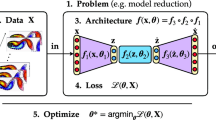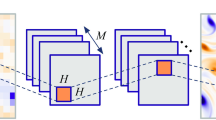Abstract
Modeled Reynolds stress is a major source of model-form uncertainties in Reynolds-averaged Navier–Stokes (RANS) simulations. Recently, a physics-informed machine learning (PIML) approach has been proposed for reconstructing the discrepancies in RANS-modeled Reynolds stresses. The merits of the PIML framework have been demonstrated in several canonical incompressible flows. However, its performance on high-Mach-number flows is still not clear. In this work, we use the PIML approach to predict the discrepancies in RANS-modeled Reynolds stresses in high-Mach-number flat-plate turbulent boundary layers by using an existing DNS database. Specifically, the discrepancy function is first constructed using a DNS training flow and then used to correct RANS-predicted Reynolds stresses under flow conditions different from the DNS. The machine learning technique is shown to significantly improve RANS-modeled turbulent normal stresses, the turbulent kinetic energy, and the Reynolds stress anisotropy. Improvements are consistently observed when different training datasets are used. Moreover, a high-dimensional visualization technique and a distance metrics are used to provide a priori assessment of prediction confidence based only on RANS simulations. This study demonstrates that the PIML approach is a computationally affordable technique for improving the accuracy of RANS-modeled Reynolds stresses for high-Mach-number turbulent flows when there is a lack of experiments and high-fidelity simulations.
Similar content being viewed by others
References
Ansys fluent user guide, release 15.0. ANSYS Inc (2013)
Banerjee, S., Krahl, R., Durst, F., Zenger, C.: Presentation of anisotropy properties of turbulence, invariants versus eigenvalue approaches. J. Turbul. 8, N32 (2007)
Cheung, S.H., Oliver, T.A., Prudencio, E.E., Prudhomme, S., Moser, R.D.: Bayesian uncertainty analysis with applications to turbulence modeling. Reliab. Eng. Syst. Saf. 96(9), 1137–1149 (2011)
Craft, T., Launder, B., Suga, K.: Development and application of a cubic eddy-viscosity model of turbulence. Int. J. Heat Fluid Flow 17(2), 108–115 (1996)
Dow, E., Wang, Q.: Quantification of structural uncertainties in the \(k\)–\(\omega \) turbulence model. In: 52nd AIAA/ASME/ASCE/AHS/ASC Structures, Structural Dynamics and Materials Conference, AIAA, Denver, Colorado, pp. 2011–1762 (2011)
Duan, L., Choudhari, M.M.: Analysis of numerical simulation database for pressure fluctuations induced by high-speed turbulent boundary layers. AIAA Paper 2014-2912 (2014)
Duan, L., Beekman, I., Martin, M.: Direct numerical simulation of hypersonic turbulent boundary layers. Part 3. Effect of mach number. J. Fluid Mech. 672, 245–267 (2011)
Duan, L., Choudhari, M.M., Wu, M.: Numerical study of acoustic radiation due to a supersonic turbulent boundary layer. J. Fluid Mech. 746, 165–192 (2014)
Duan, L., Choudhari, M.M., Zhang, C.: Pressure fluctuations induced by a hypersonic turbulent boundary layer. J. Fluid Mech. 804, 578–607 (2016)
Duraisamy, K., Iaccarino, G., Xiao, H.: Turbulence modeling in the age of data. (2018). arXiv preprint arXiV:1804.00183
Durbin, P.A., Reif, B.P.: Statistical Theory and Modeling for Turbulent Flows. Wiley, Hoboken (2011)
Edeling, W., Cinnella, P., Dwight, R.P.: Predictive RANS simulations via Bayesian model-scenario averaging. J. Comput. Phys. 275, 65–91 (2014a)
Edeling, W., Cinnella, P., Dwight, R.P., Bijl, H.: Bayesian estimates of parameter variability in the \(k\)-\(\varepsilon \) turbulence model. J. Comput. Phys. 258, 73–94 (2014b)
Emory, M., Larsson, J., Iaccarino, G.: Modeling of structural uncertainties in Reynolds-averaged Navier–Stokes closures. Phys. Fluids 25(11), 110,822 (2013)
Friedman, J., Hastie, T., Tibshirani, R.: The elements of statistical learning, vol 1. Springer series in statistics New York, NY, USA (2001)
Gatski, T., Jongen, T.: Nonlinear eddy viscosity and algebraic stress models for solving complex turbulent flows. Prog. Aerospace Sci. 36(8), 655–682 (2000)
Goldberg, U., Batten, P., Palaniswamy, S., Chakravarthy, S., Peroomian, O.: Hypersonic flow predictions using linear and nonlinear turbulence closures. J. Aircr. 37(4), 671–675 (2000)
Huang, P., Coleman, G., Bradshaw, P.: Compressible turbulent channel flows: DNS results and modelling. J. Fluid Mech. 305, 185–218 (1995)
James, G., Witten, D., Hastie, T., Tibshirani, R.: An Introduction to Statistical Learning, vol. 112. Springer, Berlin (2013)
Jiang, G., Shu, C.: Efficient implementation of weighted ENO schemes. J. Comput. Phys. 126(1), 202–228 (1996)
Johnson, R.W.: Handbook of Fluid Dynamics. CRC Press, Boca Raton (2016)
Kennedy, M.C., O’Hagan, A.: Bayesian calibration of computer models. J. R. Stat. Soc. Ser. B (Stat. Methodol.) 63(3), 425–464 (2001)
Keyes, F.G.: A summary of viscosity and heat-conduction data for He, A, \(H_2\), \(O_2\), \(CO\), \(CO_2\), \(H_2 O\), and air. Trans. Am. Soc. Mech. Eng. 73, 589–596 (1951)
Ling, J., Templeton, J.: Evaluation of machine learning algorithms for prediction of regions of high Reynolds averaged Navier Stokes uncertainty. Phys. Fluids (1994-present) 27(8), 085,103 (2015)
Ling, J., Jones, R., Templeton, J.: Machine learning strategies for systems with invariance properties. J. Comput. Phys. 318, 22–35 (2016a)
Ling, J., Kurzawski, A., Templeton, J.: Reynolds averaged turbulence modelling using deep neural networks with embedded invariance. J. Fluid Mech. 807, 155–166 (2016b)
Ling, J., Ruiz, A., Lacaze, G., Oefelein, J.: Uncertainty analysis and data-driven model advances for a jet-in-crossflow. J. Turbomach. 139(2), 021,008 (2017)
Lvd, Maaten, Hinton, G.: Visualizing data using t-SNE. J. Mach. Learn. Res. 9(Nov), 2579–2605 (2008)
Menter, F.R.: Two-equation eddy-viscosity turbulence models for engineering applications. AIAA J. 32(8), 1598–1605 (1994)
Nieckele, A., Thompson, R., Mompean, G.: Anisotropic Reynolds stress tensor representation in shear flows using DNS and experimental data. J. Turbul. 17(6), 602–632 (2016)
Oliver, T.A., Moser, R.D.: Bayesian uncertainty quantification applied to RANS turbulence models. In: Journal of Physics: Conference Series, IOP Publishing vol 318, p. 042032 (2011)
Parish, E.J., Duraisamy, K.: A paradigm for data-driven predictive modeling using field inversion and machine learning. J. Comput. Phys. 305, 758–774 (2016)
Pedregosa, F., Varoquaux, G., Gramfort, A., Michel, V., Thirion, B., Grisel, O., Blondel, M., Prettenhofer, P., Weiss, R., Dubourg, V., Vanderplas, J., Passos, A., Cournapeau, D., Brucher, M., Perrot, M., Duchesnay, E.: Scikit-learn: machine learning in Python. J. Mach. Learn. Res. 12, 2825–2830 (2011)
Ray, J., Lefantzi, S., Arunajatesan, S., Dechant, L.: Bayesian parameter estimation of a \(k\)-\(\varepsilon \) model for accurate jet-in-crossflow simulations. AIAA J. 54(8), 1–17 (2016)
Rumsey, C.L.: Compressibility considerations for \(k\)-\(\omega \) turbulence models in hypersonic boundary-layer applications. J. Spacecr. Rockets 47(1), 11–20 (2010)
Sebastian, J.J., James, S.E., Suryan, A.: Computational study of hypersonic flow past spiked blunt body using RANS and DSMC method. Procedia Technol. 25, 892–899 (2016)
Singh, A.P., Duraisamy, K.: Using field inversion to quantify functional errors in turbulence closures. Phys. Fluids 28(045), 110 (2016)
Smits, A.J., Dussauge, J.P.: Turbulent Shear Layers in Supersonic Flow, 2nd edn. American Institute of Physics, College Park (2006)
So, R., Jin, L., Gatski, T.: An explicit algebraic reynolds stress and heat flux model for incompressible turbulence: part i non-isothermal flow. Theor. Comput. Fluid Dyn. 17(5), 351–376 (2004)
Taylor, E.M., Wu, M., Martín, M.P.: Optimization of nonlinear error sources for weighted non-oscillatory methods in direct numerical simulations of compressible turbulence. J. Comput. Phys. 223, 384–397 (2006)
Thompson, K.W.: Time dependent boundary conditions for hyperbolic systems. J. Comput. Phys. 68(1), 1–24 (1987)
Touber, E., Sandham, N.D.: Oblique shock impinging on a turbulent boundary layer: low-frequency mechanisms. AIAA Paper 2008-4170 (2008)
Trettel, A., Larsson, J.: Mean velocity scaling for compressible wall turbulence with heat transfer. Phys. Fluids 28(2), 026,102 (2016)
Wang, J., Wu, J., Ling, J., Iaccarino, G., Xiao, H.: Physics-informed machine learning for predictive turbulence modeling: toward a complete framework. In: 2016 Proceedings of the CTR Summer Program, Stanford University, CA, p. 1 (2016a)
Wang, J.X., Sun, R., Xiao, H.: Quantification of uncertainties in turbulence modeling: a comparison of physics-based and random matrix theoretic approaches. Int. J. Heat Fluid Flow 62(B), 577–592 (2016b)
Wang, J.X., Wu, J.L., Xiao, H.: Incorporating prior knowledge for quantifying and reducing model-form uncertainty in RANS simulations. Int. J. Uncertain. Quantif. 6(2), 109–126 (2016c)
Wang, J.X., Wu, J., Ling, J., Iaccarino, G., Xiao, H.: A comprehensive physics-informed machine learning framework for predictive turbulence modeling, submitted, (2017a). arXiv:1701.07102
Wang, J.X., Wu, J., Xiao, H.: Physics informed machine learning approach for reconstructing Reynolds stress modeling discrepancies based on DNS data. Phys. Rev. Fluids 2(3), 1–22 (2017b)
Williamson, J.: Low-storage Runge–Kutta schemes. J. Comput. Phys. 35(1), 48–56 (1980)
Wu, J., Wang, J., Xiao, H., Ling, J.: Visualization of high dimensional turbulence simulation data using t-SNE. In: 19th AIAA Non-Deterministic Approaches Conference, p. 1770 (2017a)
Wu, J.L., Wang, J.X., Xiao, H.: A Bayesian calibration–prediction method for reducing model-form uncertainties with application in RANS simulations. Flow, Turbulence and Combustion, pp. 1–26 (2015)
Wu, J.L., Wang, J.X., Xiao, H., Ling, J.: A priori assessment of prediction confidence for data-driven turbulence modeling. Flow, Turbulence and Combustion, pp. 1–22 (2017b)
Wu, J.L., Xiao, H., Paterson, E.: Physics-informed machine learning approach for augmenting turbulence models: a comprehensive framework. Phys. Rev. Fluids 3(074), 602 (2018). https://doi.org/10.1103/PhysRevFluids.3.074602
Wu, M., Martín, M.P.: Direct numerical simulation of supersonic boundary layer over a compression ramp. AIAA J. 45(4), 879–889 (2007)
Wu, X.: Inflow turbulence generation methods. Annu. Rev. Fluid Mech. 49, 23–49 (2017)
Xiao, H., Wu, J.L., Wang, J.X., Sun, R., Roy, C.: Quantifying and reducing model-form uncertainties in Reynolds-averaged Navier–Stokes simulations: a data-driven, physics-informed Bayesian approach. J. Comput. Phys. 324, 115–136 (2016)
Xu, S., Martín, M.P.: Assessment of inflow boundary conditions for compressible turbulent boundary layers. Phys. Fluids 16(7), 2623–2639 (2004)
Zhang, C., Duan, L., Choudhari, M.M.: Effect of wall cooling on boundary-layer-induced pressure fluctuations at Mach 6. J. Fluid Mech. 822, 5–30 (2017)
Acknowledgements
The DNS database was produced based upon the work supported by AFOSR under Grant FA9550-14-1-0170 (Program Manager I. Leyva) and NASA Langley Research Center under Grant NNL09AA00A (through the National Institute of Aerospace). Computational resources for the DNS were provided by the NASA Advanced Supercomputing Division, the DoD High-Performance Computing Modernization Program, and the NSF’s Petascale Computing Resource Allocations Program (NSF ACI-1640865). Any opinions, findings, and conclusions or recommendations expressed in this material are those of the authors and do not necessarily reflect the views of the United States Air Force. We also thank the anonymous reviewers for their comments, which helped improving the quality and clarity of the manuscript.
Author information
Authors and Affiliations
Corresponding author
Additional information
Communicated by Daniel J. Bodony.
Publisher's Note
Springer Nature remains neutral with regard to jurisdictional claims in published maps and institutional affiliations.
Rights and permissions
About this article
Cite this article
Wang, JX., Huang, J., Duan, L. et al. Prediction of Reynolds stresses in high-Mach-number turbulent boundary layers using physics-informed machine learning. Theor. Comput. Fluid Dyn. 33, 1–19 (2019). https://doi.org/10.1007/s00162-018-0480-2
Received:
Accepted:
Published:
Issue Date:
DOI: https://doi.org/10.1007/s00162-018-0480-2




